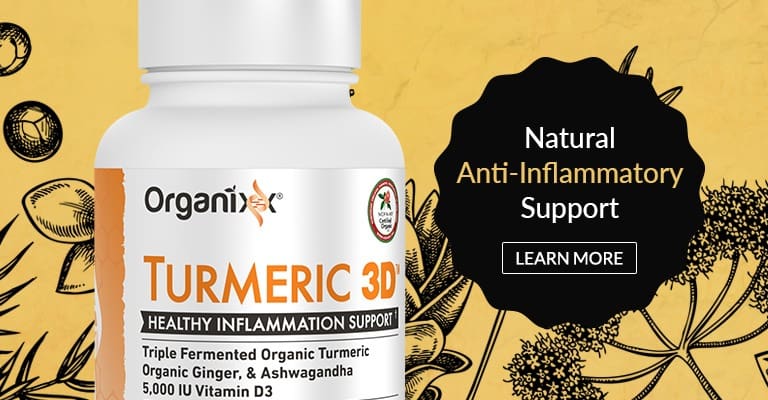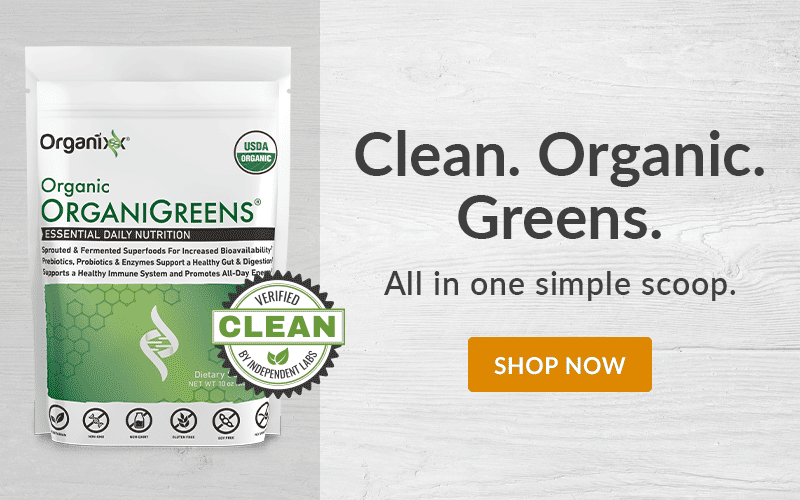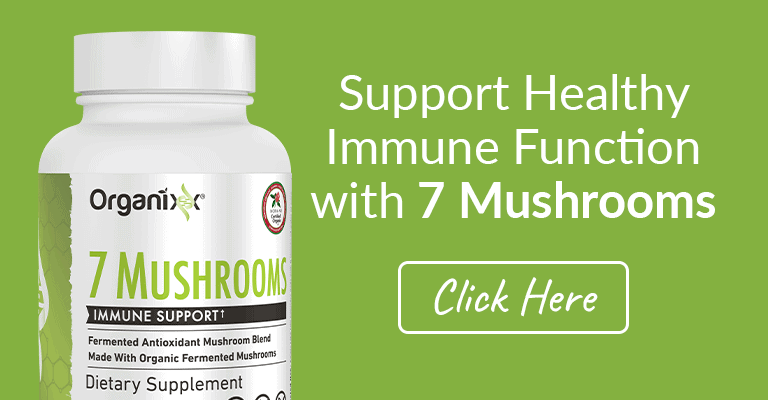Ahhh, the sauna. It’s an age-old experience that brings peace, calm, relaxation and even a little bit of luxury to mind. What you may not know, however, is that sitting in a sauna is also one of the best activities for releasing toxins and can be a great way to boost your immune system.
What Is Hyperthermia?
All saunas raise your body temperature above the typical 98.6 degrees. This is called hyperthermia.
Creating hyperthermia to the point of heat exhaustion or stroke can be extremely dangerous, but controlled hyperthermia, or thermotherapy, comes with many proven health benefits that may surprise you. Did you know that temperature plays a part in almost every interaction that occurs in your body, and that a low base body temperature often accompanies many common disease conditions?
“Heat is a form of energy, and every reaction in a human body occurs at a certain energy or temperature level [1],” says Dr. Mark Sircus, Ac., OMD, a prolific author and expert in natural medicine.
Diabetes, hypothyroidism, infection, sepsis, cancer, chronic stress, and drug addiction are among the conditions which are often accompanied by lower overall body temperature.
According to Dr. Nobuhiro Yoshimuzi, author of the book The Fourth Treatment for Medical Refugees, a mere 1-degree decline in overall body temperature results in a 40% decline in immune function [2].
The opposite is also true, however. If your overall body temperature increases by one degree, there can be a 40% increase in immune function. Also, many studies have shown that controlled hyperthermia can help with some disease conditions, including cancer.
According to the National Cancer Institute, “research has shown that high temperatures can damage and kill cancer cells, usually with minimal injury to normal tissues [3].”
How Heat Shock Proteins Can Help Prevent Disease
Hyperthermia aids your body by “stressing it out” just a little bit. As we usually hear that stress is bad, this may seem counterintuitive. But remember that we are talking about short bursts of heat-induced stress, such as being in a sauna for no more than 10 minutes followed by a cool-down and lots of water.
This kind of stress is called hormesis. Hormesis kick-starts the production of substances in the body called Heat Shock Proteins, or HSPs. While damaged HSPs can be detrimental, healthy HSPs in your system instigate a cascade of good news for your body by boosting healthy mitochondrial function.
What Are Mitochondria?
Mitochondria are the “energy generators” of your cells. HSPs help to remove old and worn mitochondria while generating new ones, which help prevent disease.
The benefits of hyperthermia in generating HPSs are especially important as we age. Studies show that the older we are, the less adept our bodies are at producing HSPs.
An in vivo study conducted by the University of Texas, San Antonio, and published in the Journal of Gerontology found that aging resulted in a decrease in the immune substances needed to synthesize certain kinds of heat shock proteins. In some cases, the rate of decrease was close to 40% [4].
Dry, Wet, and Infrared: Types of Saunas and What They Do
 All saunas, from the traditional Finnish saunas to more modern infrared saunas, use heat to elicit the healing mechanisms of hyperthermia as well as detoxification through the sweat glands.
All saunas, from the traditional Finnish saunas to more modern infrared saunas, use heat to elicit the healing mechanisms of hyperthermia as well as detoxification through the sweat glands.
A comprehensive study conducted in 2009 at the Southwest College of Naturopathic Medicine in Tempe, Arizona, found that “regular sauna therapy (either radiant heat or far infrared units) appears to be safe and offers multiple health benefits to regular users,” helping with chronic conditions, environmentally-induced illness, and even addictions [5].
Here are just a few of the different kinds of saunas available today and what they can do:
Dry Saunas
A dry sauna is simply a small room that is heated using hot rocks or other means. A dry sauna is perhaps the fastest way to relax from the stresses of the day and can provide you with all the benefits of controlled hyperthermia as mentioned above.
It will relax tired muscles and make you sweat, which can help remove surface-level toxins. It can also open pores, cleanse the skin, and remove excess sodium from the body.
The jury is still out, however, as to how effective dry saunas can be for removing toxins embedded deep within tissues.
Wet Saunas
A wet sauna is also called a “steam room” and uses steam to heat up a small enclosure to between 100 to 114 degrees Fahrenheit (approx 38-46°C). Wet saunas provide all of the benefits of dry saunas and more. Spending about 10 to 15 minutes in the steam room can be good for the sinuses since the humidity opens them up and loosens mucus.
If you are asthmatic, you may want to avoid wet saunas since the humidity may bring on an attack. Like dry saunas, most evidence does not support deep detoxification while using a wet sauna. Even so, the relaxation and hyperthermia benefits have made wet saunas an enduring popular choice.
Infrared Saunas
Infrared saunas are also known as low-level light therapy, photobiomodulation, red light therapy, or simply “heat therapy.” They come in three types: Near, far, and full spectrum.
Infrared saunas use light therapy to mimic certain aspects of the sun. Sunlight contains both visible and invisible light; examples of invisible light are infrared and ultraviolet.
While ultraviolet light can be harmful to the body, infrared rays can penetrate deep into tissues where they can “dislodge and dissolve” harmful toxins, revitalize cells, and boost metabolism.
The difference between the three kinds of infrared saunas has to do with the length of the light wave they use.
Near-infrared is the shortest wavelength (just beyond visible light) and can be absorbed below the surface of the skin for a gentle yet powerful detoxifying sweat.
Far infrared saunas provide the longest wavelength, which some manufacturers claim can penetrate up to 9 inches into the body, increasing circulation and releasing oxygen. Full-spectrum saunas provide the ability to adjust the wavelength depending on need.
Most evidence-based studies have been conducted on far infrared saunas. A 2009 meta-analysis conducted by the University of British Columbia in Vancouver, Canada, looked at the cardiovascular benefits of far infrared sauna use.
It found that far infrared saunas can be beneficial for “normalizing blood pressure and treating congestive heart failure… chronic pain… chronic fatigue syndrome and [normalizing] cholesterol [levels] [6].”
Maximizing Your Sauna Experience: 10 Tips Before You Sweat
Follow these ten tips for a calming, healthy, and safe sauna experience:
#1: Don’t overdo it. Pay attention to how you’re feeling and check in with your body every two minutes or so. Be aware of signs indicating that you have been in too long. These include drowsiness, dizziness, headache, and nausea. Never fall asleep in the sauna!
#2: Take breaks. You want to take breaks to drink water and cool down before you get to the point of feeling any kind of discomfort or pain. While everyone is different, most individuals take a break about every 10 minutes.
#3: Consider hot/cold therapy along with your sauna. During a break is a great time to take a cold shower, if one is available. Yes, it is a bit torturous at first to plunge into cold water after your body has been heated up. On the other hand, you may come to enjoy the refreshing feeling that hot/cold therapy can provide. Hot/cold therapy has also been known to increase circulation.
#4: Drink LOTS of water. Water is a must before, during, and especially after your sauna experience. Most experts advise a full 16 ounces of water before going into a sauna and between 16 to 32 ounces when you are done to avoid dehydration. “Detox waters” are a tasty way to stay hydrated and aid in detoxing the body naturally.
#5: Don’t go in with a full belly. Eating a large meal right before the sauna can lead to nausea and even vomiting for some. Wait until after your sauna when your digestive system and body are in “relaxation mode” before enjoying a good meal.
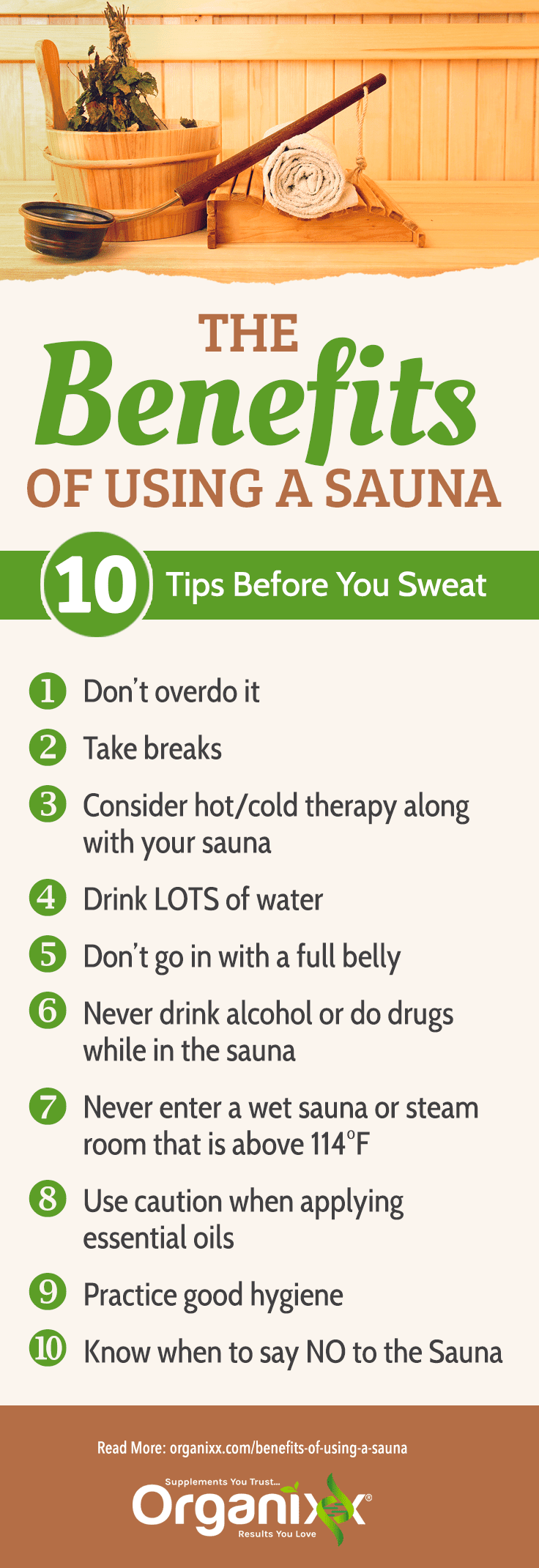
#6: Never drink alcohol or do drugs while in the sauna. Drinking, smoking, or using drugs while exposing yourself to high heat can be extremely dangerous and can lead to seizures, coma, and even death.
#7: Never enter a steam room that is above 114 degrees F. 100 to 114 degrees is the typical range in which steam rooms operate. If it seems too hot, be sure to contact someone to check the temperature right away.
#8: Use caution when applying essential oils. Essential oils can be a great addition to your steam experience. Peppermint can open the sinuses while lavender can help you relax. Citrus essential oil can be reinvigorating, while tea tree is an anti-microbial. However, if you are in a public sauna, there may be others who are sensitive to these scents, so it is a good idea not to use them. Remember that a little goes a long way when it comes to essential oils, especially in a steam room. Start out with a drop or two. Too much essential oil can burn the skin and eyes.
#9: Practice good hygiene. Public saunas, in particular, can be breeding grounds for opportunistic bacteria. Always sit on a towel and wear waterproof sandals to avoid being exposed to pathogenic microbes.
#10: Know when to say NO to the Sauna. If you are pregnant, menopausal, suffer from migraine headaches, have high blood pressure, have heart disease/cardiovascular disorder, have hormonal imbalances, or a temperature-regulation issue such as hyperthyroidism or Hashimoto’s thyroiditis, take caution when using a sauna. Talk to a qualified health professional before using.
Hopefully, this article has given you a little more information on what modern versions of this ancient detoxification experience can do. There are many benefits to using a sauna; whether dry, wet, or infrared, all saunas evoke controlled hyperthermia and can benefit the body if used correctly. Consider giving them a try today!
Organixx Cleanse & Detoxx is a two-step formula that provides a gentle yet powerful full-body detox using organic botanical ingredients. Naturally purge your body of toxins, chemicals, free radicals, heavy metals, waste, as well as bacteria, and pesticides. Easily cleanse your colon, liver, kidneys, lungs, and lymphatic system resulting in increased energy, and better digestion with more nutrient absorption, in addition to improved immunity, mental clarity, and overall health and wellbeing.
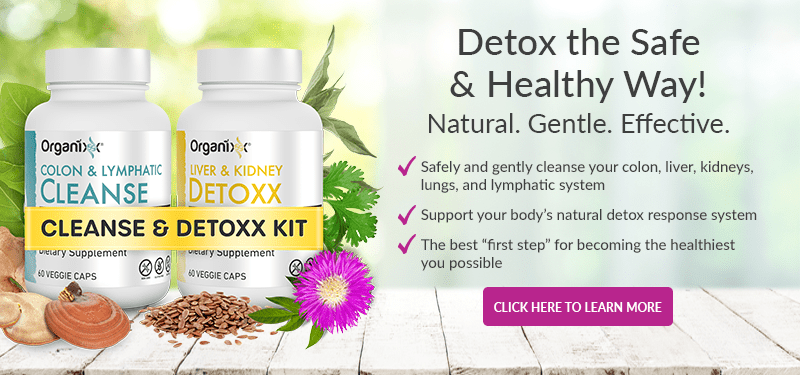
Turmeric (known scientifically as Curcuma longa) is an earthy root spice belonging to the ginger family. Believed to have been originally cultivated in India and Indonesia, turmeric is widely used for cooking, dyeing fabrics, and cosmetics. Turmeric is very popular at the moment for its potent health-giving benefits… but turmeric’s use actually dates back centuries.
Indeed, turmeric has long been used in Ayurveda, the traditional Indian system of medicine. Some of the traditional uses of turmeric in Ayurveda include:
- Helping to maintain healthy levels of gut bacteria
- Protecting against stomach disorders
- Helping to cleanse the liver and increase the flow of bile, necessary for breaking down dietary fats during digestion
- Helping to manage blood sugar
- Helping to support a body plagued with arthritis inflammation and pain.
Turmeric and Skin: Ayurveda’s Traditional Uses
According to the ancient Ayurvedic text the Charaka Samhita, turmeric’s ability to manage inflammation levels in the body is the reason why it benefits so many health conditions – including those affecting the skin.
For example, the juice of turmeric was used to help heal wounds, bruises, and leech bites. A paste made of turmeric alone or with neem leaves was used to treat ringworm, itching, eczema, and many other parasitic skin conditions.
Hemorrhoids (piles) were treated by Ayurvedic healers with an ointment of turmeric, hemp leaves, onions, and warm mustard oil or linseed oil, applied externally.
Pastes of turmeric were used to relieve skin itching and ulcers during infections of smallpox, chickenpox, and shingles, and also to treat various skin blemishes.
Ayurveda and Skin
Turmeric has long been used by traditional Ayurvedic healers to treat skin conditions in the form of creams, lotions, pastes, and ointments. However it’s not just the traditionalists who believe in turmeric’s effectiveness for treating skin conditions. Modern scientific and clinical evidence indicates that turmeric can potentially be effective with:
- reversing some of the skin damage caused by the sun and UV light (known as photoaging)
- protecting against skin itching or pruritus
- reducing the severity of the damage caused by radiation therapy (radiation dermatitis)
- helping to manage psoriasis
- helping to prevent fungal skin conditions
5 Ways Turmeric Has Scientifically Been Shown to Improve Skin
Let’s take a closer look at 5 reported beneficial applications for turmeric and skin…
#1. Reversing Facial Photoaging
 Photoaging is a term used to describe premature aging of the skin caused by repeated exposure to ultraviolet radiation (UV) – mainly from the sun, but also from artificial UV sources.
Photoaging is a term used to describe premature aging of the skin caused by repeated exposure to ultraviolet radiation (UV) – mainly from the sun, but also from artificial UV sources.
Photoaged skin typically shows areas of greater pigmentation and becomes thin and easily damaged.
A randomized, placebo-controlled, double-blind study conducted in 2007 evaluated the efficacy of Tricutan – a herbal combination gel containing turmeric, rosemary, and gotu kola – in improving skin firmness and elasticity and improving the signs of photoaging in 25 women aged between 34 to 67 years.
Rosemary is believed to moisturize skin, support healthy collagen development, and counter skin-damaging free radicals. Gotu kola, also known as Indian pennywort, has long been used to heal wounds and treat skin conditions such as leprosy and psoriasis for thousands of years in India, China, and Indonesia.
The results of this 4-week study showed that treatment with Tricutan gel improved skin firmness and clinical evaluation in the women being tested. Further, according to their self-evaluation, the participants felt that Tricutan gel gave significantly better results than the control.
Unfortunately, a major limitation of this study is that the potential benefits of turmeric cannot be separated from those potentially caused by rosemary and gotu kola.
However, curcumin (one of the main active compounds in turmeric) has been shown to block an enzyme in our body known as phosphorylase kinase, with beneficial effects for many skin conditions including burns and photoaging. For instance, a 2013 study showed that curcumin gel helps to heal burns rapidly, with little or no residual scarring.
Additionally, the gel also helped to reverse many of the adverse changes seen in photo-damaged skin, suggesting that curcumin could be used as an effective, natural, and non-toxic ingredient in sunscreen creams and lotions.
#2. Protection Against Itching
Pruritus is the scientific term used to describe severe itching, which can happen because of many underlying causes. For instance, uremic pruritus is caused by chronic kidney disease. Uremia means having excessive urea in the blood, which occurs when both kidneys stop working – which is known as renal failure.
In a randomized, double-blind, placebo-controlled study conducted in 2014, 100 dialysis subjects with uremic pruritus were given either three turmeric capsules daily or control starch capsules for 8 weeks. At the end of the study, the researchers found that dialysis subjects in the curcumin group experienced significantly less itching relative to subjects in the control group.
Simultaneously, they also found that curcumin significantly reduced the levels of high-sensitivity C-reactive protein (known scientifically as hs-CRP), a well-known marker of inflammation.
 Exposure to sulphur mustard severely damages the skin, typically leading to severe pruritus. In a 2012 study, 96 male subjects with sulfur mustard-induced pruritus were given either one gram of curcumin or placebo capsules daily for 4 weeks, while being constantly evaluated for pruritus severity using three different assessment methods.
Exposure to sulphur mustard severely damages the skin, typically leading to severe pruritus. In a 2012 study, 96 male subjects with sulfur mustard-induced pruritus were given either one gram of curcumin or placebo capsules daily for 4 weeks, while being constantly evaluated for pruritus severity using three different assessment methods.
At the end of the study, the researchers reported that the curcumin group showed a significant reduction in pruritus severity, as measured by all three methods of assessment.
Further, the levels of substance P, a strong stimulator of pruritus, was seen to be significantly reduced in the curcumin group compared with the placebo group. At the same time, the innate antioxidant enzymes superoxide dismutase, glutathione peroxidase, and catalase were seen to be higher in the curcumin group relative to placebo.
In other words, turmeric consumption increased levels of natural antioxidant enzyme systems.
Similarly, another 2012 study looked at the effects of curcumin on various inflammatory markers in the blood of 96 male Iranian war veterans suffering from chronic sulphur mustard-induced pruritic skin lesions.
These men were randomly given either one gram of curcumin or control daily for four weeks. At the end of the study, inflammatory markers such as interleukin-8 (known scientifically as IL-8 and an important component of the immune system) and high-sensitivity C-reactive protein (hs-CRP) were significantly lower in the group being treated with curcumin, suggesting that curcumin can reduce sulphur mustard-induced pruritic complications – and likely other forms of pruritus – by helping to support healthy inflammation levels.
#3. Reducing Severity of Radiation Dermatitis
Radiation therapy is a widely accepted form of conventional medical treatment. Unfortunately, it causes severe side effects and can reduce both quality of life and long-term survival.
One very common side effect of radiation therapy is dermatitis, also known as eczema – which is typically characterized by itchiness, red skin, and a rash, usually on very specific areas of the skin and sometimes over the entire body.
Up to 85 percent of all patients undergoing radiation therapy are likely to experience moderate to severe skin reactions within a few days to weeks, which increase after 2 to 3 weeks and continue to build up as radiation therapy goes on.
Radiation dermatitis (also known as radiodermatitis, x-ray dermatitis, radiation skin damage, or a radiation burn) varies in severity from person to person. Symptoms such as dry skin, itching, discomfort, pain, warmth, and burning have been reported for up to 4 weeks after radiation treatment has ended.
Redness of the skin or mucous membranes caused by greater blood flow in delicate blood vessels just under the skin known as capillaries has also been known to happen. Management of radiation dermatitis is crucial, as this can help to improve the therapeutic benefits of radiation therapy, prevent infections, and reduce skin injury and scarring.
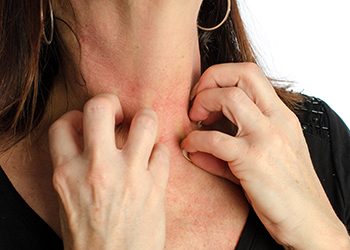
Currently there is no effective standard treatment to prevent or treat radiation skin dermatitis.
Promisingly, the curcumin in turmeric has been shown to be helpful in various skin conditions, including radiation dermatitis.
For instance, in 2013, a randomized, double-blind, placebo-controlled clinical study was conducted in 30 patients to assess the ability of curcumin to manage radiation dermatitis. Randomized patients were given either 2 grams of curcumin or control orally in capsule form three times daily – in other words, a total of 6 grams every day – throughout the course of radiation therapy, which lasted between 16 to 33 sessions.
At the end of the study, the researchers concluded that orally given curcumin significantly reduced severity of radiation dermatitis and a condition known as moist desquamation after radiation therapy.
Moist desquamation is a skin condition that happens as a consequence of radiation exposure in which the skin thins and begins to weep, or ooze liquid, because of a weakening of skin structure.
The study researchers further stated that “it is possible that a higher oral dose of curcumin, such as ≥8.0 grams daily, may be more effective against radiation dermatitis severity including erythema and skin reactions.”
In 2014, another study was undertaken jointly at Father Muller Medical College in Mangalore, India, and the University of South Carolina in Columbia, SC, to assess the effectiveness of a popular, commercially available herbal-based skin cream for preventing severe dermatitis in patients requiring radiation therapy. This cream contains turmeric and sandalwood oil and has been used in India for over 40 years to enhance the complexion and rejuvenate the skin.
As radiation therapy proceeded, signs of skin damage began to appear in the third week. Roughly 20 percent of the volunteers in the control group and 8 percent of the patients in the cream-treated group developed dermatitis.
Continuation of radiation treatment into the fourth week increased the incidence of dermatitis to 75 percent for the control group and only 37.5 percent in the cream-treated group – a statistically significant difference.
Both incidence of dermatitis and the degree increased in both groups in subsequent weeks, reaching a peak at week 7.
However, a direct comparison showed that patients using the turmeric and sandalwood cream had a significantly delayed appearance and reduced levels of dermatitis at all time points during radiation therapy.
While these initial studies are very promising, larger clinical trials are needed to assess the extent of turmeric’s effectiveness in helping to manage radiation dermatitis.
#4. Management of Psoriasis
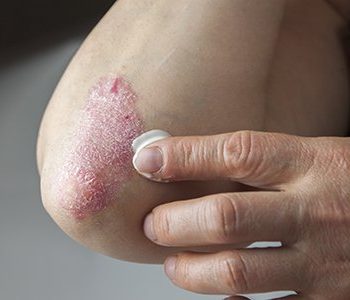 Psoriasis is a persistent yet unpredictable skin disorder in which skin cells grow up to 10 times faster than normal.
Psoriasis is a persistent yet unpredictable skin disorder in which skin cells grow up to 10 times faster than normal.
As underlying cells reach the skin’s surface and die, their sheer numbers lead to raised, red plaques covered with white scales – typically seen on the knees, elbows, and scalp, although it can also affect the torso, palms, and soles of the feet.
Plaque psoriasis, the most common form of this condition, includes symptoms such as red skin, often covered with loose, silver-colored scales. These lesions may be itchy and painful, and sometimes they also crack and bleed.
In laboratory studies, turmeric has been shown to block many of the inflammatory enzymes involved in triggering psoriasis.
In a randomized, prospective placebo-controlled, double-blind clinical trial conducted in 2015, the efficacy and safety of an externally applied turmeric microemulgel was assessed on 34 patients suffering from mild to moderate plaque psoriasis.
The results of this study show that the clinical and quality of life parameters in patients treated with the turmeric microemulgel were significantly better relative to patients with untreated lesions. Further, observed side effects of treatment were trivial.
These results appear to indicate that gels and creams containing turmeric may be an effective and safe way of helping to manage psoriasis symptoms.
#5. Helping to Stop Fungal Skin Conditions
Turmeric is widely used in Thai traditional medicine for treating rash, itching, ringworm, athlete’s foot, and jock itch. Previous studies have reported that turmeric oil as well as multiple curcuminoid compounds are effective against various species of dermatophytes, a type of fungus that causes skin diseases.
For instance, in a 2013 study, two turmeric creams containing 6 and 10 percent turmeric oil were tested against various types of dermatophytes. Ar-turmerone, a potent compound present in turmeric oil, was seen to be effective against dermatophytes, although further studies are needed to assess the safety and stability of this compound.
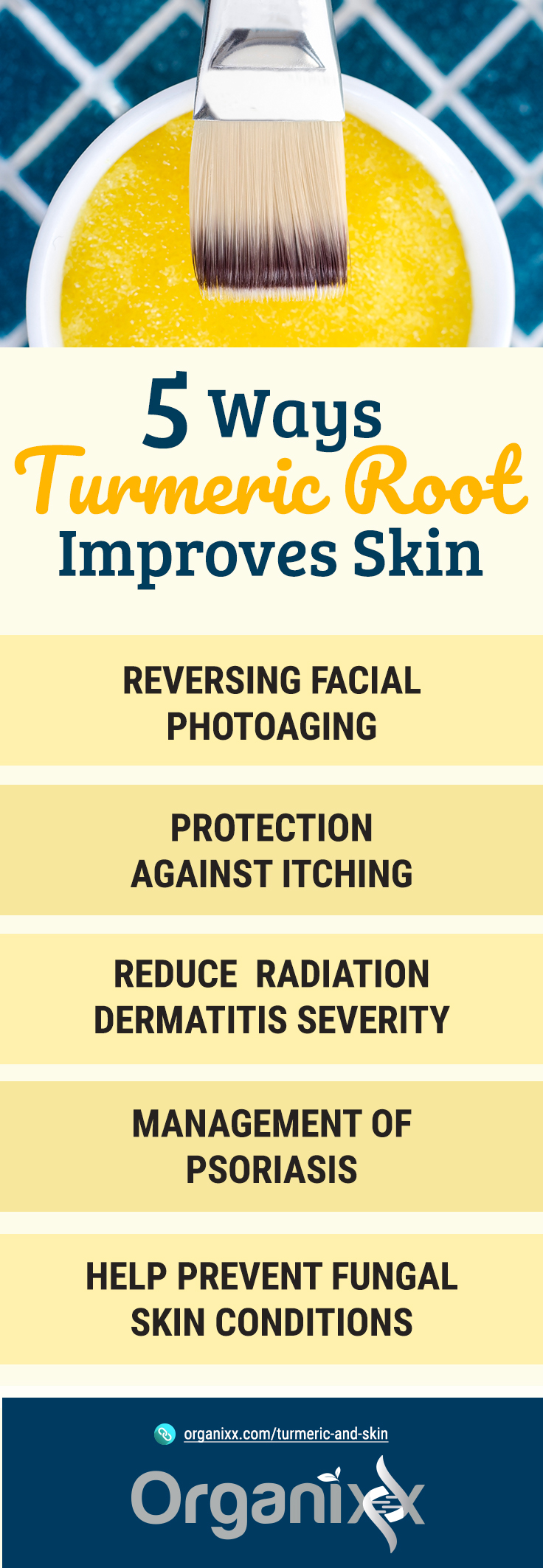
Potential Adverse Effects and Contraindications of Curcumin & Turmeric
With all the buzz about turmeric and its active compound curcumin, how safe is turmeric root considered to be?
Turmeric is considered extremely safe, especially when used in whole food form and as a spice for cooking. This is obvious from the fact that nearly all Indians and many other South Asians routinely use significant amounts of turmeric in their daily cooking for their entire lives without any reported adverse effects.
However, more care is likely needed when consuming fresh turmeric juice, turmeric essential oil, tinctures, and other therapeutic formulations containing turmeric, as well as turmeric supplements. This is because the dose of turmeric – and its various powerful active ingredients, including curcumin – can vary significantly in these preparations.
It has been reported that curcumin did not show any toxicity in doses as high as 8 grams daily for 3 months in a human clinical trial, making it a very safe and attractive supplement to support healthy inflammation levels.
In fact, there were no significant toxicities of curcumin reported from almost 40 clinical trials involving over 800 participants.
That being said, it must be noted that some clinical studies have shown isolated and transient rises in liver enzymes and anticoagulant properties with turmeric because of suppression of platelet aggregation.
With doses higher than 4 grams daily, isolated cases of gastrointestinal side effects have also been reported – including loose stools, acid reflux, bloating, and abdominal discomfort.
However, in a 2013 study of 26 patients given 2.35 grams of curcumin daily for 14 days, no serious adverse events attributable to curcumin and no changes in overall activity or general health were reported.
Patients in the study actually self-reported a decrease in gut-related disturbances including nausea, vomiting, constipation, diarrhea, flatulence, and abdominal pain following two weeks of daily curcumin intake. This suggests that curcumin may be beneficial for these conditions, rather than causing them.
In some instances, curcumin has been shown to stimulate gallbladder contractions, worsening symptoms in patients with gallstones. Further, curcumin has been shown to prevent the synthesis of Hepcidin, a protein involved in iron balance in the body. Perhaps as a result, curcumin has been shown to cause a dose-dependent drop in hematocrit, hemoglobin, and blood iron levels in people with an underlying subclinical iron deficiency or anemia.
Therefore, some health experts recommend that curcumin should be taken with caution by people with low iron stores in their body, or other diseases associated with iron such as anemia.
In conclusion, while most of the currently available research indicates that turmeric and its many active ingredients are extremely safe, it is recommended that you take fresh turmeric juice, turmeric oil, tinctures, and other therapeutic formulations containing turmeric, as well as turmeric supplements, under the supervision of a qualified healthcare provider.
Turmeric 3D from Organixx provides you one of the most “bioavailable” forms of turmeric due to its unique fermentation process. This means your body experiences the maximum benefits of the purest, most potent turmeric available!
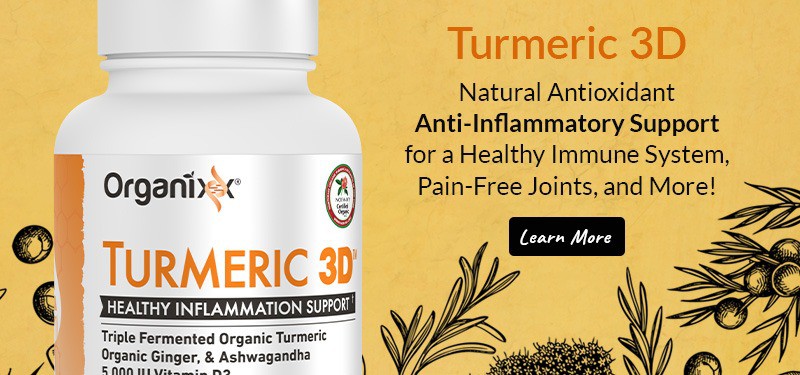
The succulent perennial Aloe vera, of the Aloaceae family, has a tremendously long history as a healing plant and there is an extensive list of recorded benefits of Aloe vera. There is also a growing body of research into aloe’s modern day potential health benefits.
Indigenous to Eastern and Southern Africa, records of Aloe vera’s use date back as far as 1750 BC. Ayurvedic medicine (Ayurveda is the ancient healing system of India) has long revered aloe, and there is rumor that Cleopatra’s soft skin was due to aloe.
Aloe is also reputed to be the reason Alexander the Great sought to conquer Madagascar – he wanted to acquire the abundant Aloe vera plants for treating the wounds of his soldiers. Even the ancient Greeks are on record as using this healing plant [1]. According to a study published in the Indian Journal of Dermatology, Aloe vera has also been used for hundreds of years in China, Mexico, and Japan [2].
Nowadays Aloe vera grows around the world, usually in hotter climates, such as the Caribbean, some Southern states, as well as Central and South America. You may know aloe as a common house plant, or even keep one on hand yourself for minor burns and other skin irritations. Indeed it is for this purpose that Aloe vera is most well-known in the Western world.
Aloe Vera for Burns
Aloe vera’s strong reputation in the West as a burn remedy began in the mid 1930s when a woman undergoing x-ray treatments developed severe dermatitis that would not go away. Aloe healed this chronic condition, which instigated informal trials on patients with radiation burns.
Then in 1953, a study on rats by Lushbaugh and Hale noted results that were supported by science, rather than mainly anecdotal observations [3].
More recently in a review of four studies, when compared to conventional treatments, Aloe vera was noted to reduce the healing time of topical burn by approximately nine days [4].

Aloe Vera Benefits: Much More than Just a Home Remedy for Burns
If you’ve personally ever applied aloe to a sunburn, you know the cool relief it offers. However, Aloe vera has far more health-supporting benefits than merely being the go-to remedy for small burns and sunburn relief.
As one 2013 study published in the journal Organic and Medicinal Chemistry Letters put it, “Due to its phytochemical composition,” aloe has shown promise in “alleviating symptoms associated with/or prevention of cardiovascular diseases, cancer, neurodegeneration, and diabetes [5].”
According to Encyclopedia.com, one of the most important phytochemicals (plant chemicals) found in Aloe vera is the polysaccharide acemannan (also known as acetylated mannose). The 2013 journal article mentioned above states that acemannan has been found to be:
“a highly effective immune stimulant, with activity against the viruses causing the flu, measles, and early stages of AIDS. It has been used effectively against some veterinary cancers, most notably sarcoma, and is being investigated as an agent to be used to treat cancer in humans [6].”
What’s in Aloe Vera Gel?
Whether you’ve favored the store-bought preparations, or cracked open a chunk of home-grown Aloe vera and scooped out the slightly sticky gel yourself, it is the slimy inner tissue that works its magic on the skin and body. This water-heavy gel is the part of the plant that holds the most bioactive compounds (phytochemicals).
According to researchers, the powerful active compounds in Aloe vera include [7,8]:
- Vitamins – including A, B (thiamine), B2 (riboflavin), B12, C, E, folate, and niacin
- Minerals – including zinc, chromium, copper, calcium, magnesium, manganese, selenium, potassium, iron, and sodium
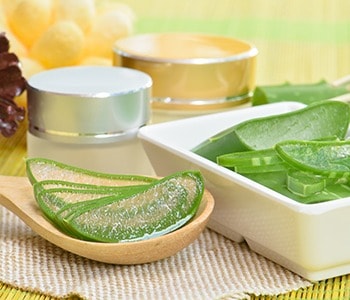 Antioxidants
Antioxidants- Anthraquinones – including aloin, lsobarbaloin, Barbaloin, and aloe-emodin, emodin, aloetic acid, anthrone-C-glycosides and chromones
- Polysaccharides – including glucomannans
- Saccharides – including acemannan, arabinose, cellulose, galactose, mannose, and xylose
- Prostaglandins – believed to play a significant role in wound healing
- Fatty acids – including linoleic acid (LA) and alpha-linoleic acid (LNA), beta-sisosterol cholesterol, campesterol, and lupeol
- Enzymes – including catalase, lipase, carboxypeptidase, acid phosphatase, alkaline phosphatase, lactic dehydrogenase, aliiase, amylase, bradykinase, cellulase, peroxidase, and lipase
- Amino acids – it provides 20 of the 22 human-required amino acids and 7 of the 8 essential amino acids
The Benefits of Aloe Vera for Digestion & Skin
With the volume of bioactive compounds and properties available in Aloe vera, it should come as no surprise that studies into this gift of nature demonstrate this medicinal plant has other benefits to health. In fact there is a plethora of research to be found in PubMed, with close to 3,500 studies being listed that include investigation into Aloe vera [9].
Some other benefits of Aloe vera of note include:
Digestion
Apart from burns, Aloe vera may be most famous as a digestive aid. This is mainly due to the latex (the yellow liquid just below the skin that surrounds the gel). It’s a known laxative that was used for many years in the United States [10].
Due to its potency and concerns over toxicity it was banned from over-the-counter use in 2002 [11]. However, the FDA does state the following about Aloe vera toxicity in a March 2016 briefing document for the Pharmacy Compounding Advisory Committee (PCAC).
“Reports of previous human experience as a food, dietary supplement, and herbal medicine in the U.S. and other parts of the world, with data reported online in the Natural Medicines Comprehensive Database and other sources (e.g., USP, WHO monographs, PubMed), suggests that Aloe vera products are generally well tolerated. Moderate and infrequent oral consumption of Aloe vera gel preparations (containing no anthraquinone derivatives) as food/beverages appears reasonably safe based on the marketed use of various products [12].”
In large amounts the anthraquinones in aloe do have a powerful purgative effect. (Purgative refers to a substance that loosens stools and increases bowel movements). According to research published in the Internet Journal of Microbiology, in smaller amounts anthraquinones aid the microbiome by increasing absorption, and acting as potent antimicrobials (killing less desirable bacteria) [13]. In addition, aloe has been noted to improve the bioavailability of vitamins in humans [14].
There is some controversy surrounding the benefits of aloe for Irritable Bowel Syndrome (IBS), with some claiming there is no definitive evidence. However, one 2013 study found that 33 patients consuming aloe twice daily had decreased discomfort [15]. It’s important to note, however, that this study found no notable difference in urgency or consistency.
There is also evidence from a 2014 animal study that ingesting aloe may assist with digestive issues involving imbalanced levels of stomach acid [16].
Skin
Aloe vera doesn’t just help your skin with burns; topical application has been found to offer some skin protection by absorbing ultraviolet light, reducing both melanin formation and hyper-pigmentation [17].
According to 2013 research published in the journal Phytotherapy Research there is also eviden ce that the baby shoots of Aloe vera support healthy skin by offering protection from the aging effects of sunlight [18]. A compound known as lignin in aloe assists aloe with its skin-nourishing abilities by aiding the penetration of active compounds [19].
ce that the baby shoots of Aloe vera support healthy skin by offering protection from the aging effects of sunlight [18]. A compound known as lignin in aloe assists aloe with its skin-nourishing abilities by aiding the penetration of active compounds [19].
Aloe vera has also been reported to have potent antibiotic, antivirus, antifungal, and anti-inflammatory effects on the skin, including the ability to help rid wounds of necrotic (dead) tissue [20-23].
Other studies have demonstrated that aloe may aid in maintaining younger looking skin by helping to increase collagen production and improve collagen elasticity, as well as reduce redness of the skin [24,25].
Tips for Using & Consuming Aloe Vera
When using aloe at home for skin applications, don’t simply squeeze out the gel from a cut leaf. This will also give you the yellow latex, which can cause irritation. Instead, scoop out the gel, leaving behind the lower layer between the skin and inner gel.
The main problem with consuming aloe is the bitter taste of the yellow latex. For this reason many people like to use it in a smoothie with other ingredients. Another important consideration is that it’s generally way too strong to eat large quantities due to its laxative properties. Separating the gel from the latex and the prickly skin is no easy feat, either. This is likely why many consumers resort to either a liquid form – either the juice or an extract in supplement form.
In the case of aloe juice, it’s important to remember the juice is likely to contain only the gel, mixed with a great deal of water, and thus will not provide several of the active compounds that are present in the green of the outer leaf.
In order to get all the health-supporting benefits of this amazing plant, look for an extract of superior quality, that is harvested and processed responsibly, from a manufacturer you trust.
The latest formula of Organic OrganiGreens is our best yet. In just one simple scoop, add 17 sprouted and fermented superfoods and botanicals, plus probiotics and enzymes, to your daily diet to fill nutritional gaps and support healthy immune function, increased energy and mental clarity, as well as digestion and detoxification processes. Easily mixes in water, smoothies, juices, and recipes, and it also tastes great – even without any added sugars.

When we are young, we don’t think about our skin much except perhaps to cover up pesky acne or how we can get a good tan. Priorities change, of course, as we age. Acne and blemishes may still be issues for us, but instead of covering them up with gobs of concealer, our years have hopefully made us wiser. Now we know that in order to achieve soft, silky, beautiful skin, it has to come from the inside out.
Take a look at these seven foods good for skin that can help you have radiant skin at any age. Many of them are chock full of antioxidants, “healthy” fats, and phytonutrients that can help reduce lines, wrinkles, prevent melanoma, and make you feel great in the process!
7 Foods Good for Skin
#1 – WATER.
Maybe it goes without saying, but seriously − staying hydrated is probably the BEST thing you can do for your skin (as well as for your entire body).
Your skin is the largest organ on your body and, just like any other organ, it is made up of cells. Cells need to be hydrated in order to work properly. When you don’t drink enough fresh, filtered water, your cells suffer and this shows in the form of dry, rough, wrinkly skin.
The body itself is made up of between 60 and 70% water. The water in your system and your skin work together to regulate dozens of functions in the body, not the least of which is temperature. According to the University of Wisconsin Hospitals and Clinics Authority, in addition to drinking at least half your weight in ounces of water per day, you can also “seal in” hydration by applying a chemical-free, preservative-free moisturizer to your skin right after you get out of the shower or tub.
#2 – GREEN TEA.
Not only does green tea give you a lift, according to several studies, but the plant-based antioxidants in green tea can provide your skin with great protection from environmental pollutants and overexposure to ultraviolet radiation from the sun.
According to a study conducted in 2012 by University Hospitals Medical Center and Louis Stokes Cleveland Veterans Affairs Medical Center in Cleveland, Ohio, green tea is an “abundant source” of plant polyphenols which can be chemoprotectant and skin protectant through boosting the immune system.
When we’re young, healthy skin is not typically the first thing on our minds. But as we get older, we learn that skin health comes from the inside out. Watch this video to learn how to keep your skin looking youthful!
#3 – GREEN LEAFY VEGGIES.
This especially includes spinach, kale, collard greens, and watercress. Spinach has shown to improve digestion and help with flushing out toxins because of its high fiber and sulphur content. Kale and watercress are definitely a friend to your skin because of their high vitamin C content.
Although research regarding vitamin C and skin health, in particular, is rare, according to the Linus Pauling Institute, the antioxidant properties of vitamin C as well as its role in collagen synthesis help make it a very important molecule for skin health. This is because ascorbic acid is found in both the dermis and epidermis layers.
Aging and too much sun exposure can lower the amount of vital vitamin C in the skin overall. According to a study conducted at the University of California, Berkeley, overexposure to ozone as well as oxidative damage can affect vitamin C stores in the epidermis in particular.
Keep in mind that one cup of kale can contain 134% of the US Recommended Daily Allowance of vitamin C. So try to get your kale on every day for skin and overall health!

#4 – HEALTHY FATS.
Healthy skin relies partly on the presence of a solid lipid (fat) layer in the hypodermis. Without this, skin begins to sag. One way to ensure a healthy lipid layer is to consume healthy fats such as monounsaturated fatty acids and omega 3s. Olive oil is one of the best sources of monounsaturated fatty acids.
A 2012 study published in the journal PLOS ONE analyzed the eating habits of over 1,200 women and over 1,600 men. They discovered that those who had a higher consumption of olive oil (more than 2 teaspoons a day) had significantly fewer signs of aging compared to those who ate less than 1 teaspoon per day.
Other sources of healthy fats include avocados, eggs, sunflower seeds, almonds, pine nuts, walnuts, and brazil nuts. Many nuts and seeds have hefty amounts of vitamin E in them which supports healthy skin growth.
The high vitamin E content in sunflower seeds has been shown to reduce severe acne in research studies. Brazil nuts, in particular, are excellent for skin health because of their high selenium content. Studies show that high-selenium diets can help reduce your risk of cancer, including skin cancer.
#5 – BERRIES.
Of course, the high antioxidant content (in the form resveratrol and other phytonutrients) in red and purple-colored berries make them ideal candidates for overall health and can protection your skin from environmental pollutants as well. Many kinds of berries also provide your body with key vitamins and minerals which enhance skin health.
Blackberries in particular are a great source of vitamin K, which helps the body’s blood clotting processes. Vitamin K is also reported to help heal wounds and lessen scarring after injury or surgery.
Blueberries are a nutritional powerhouse for the total body with proven anti-cancer and neuroprotective properties. Dark-colored berries contain anthocyanins, which are powerful antioxidants that help to shield the skin from free radicals that can damage the collagen in your skin. Blueberries, like all berries, also contain high amounts of vitamin C.
#6 – BONE B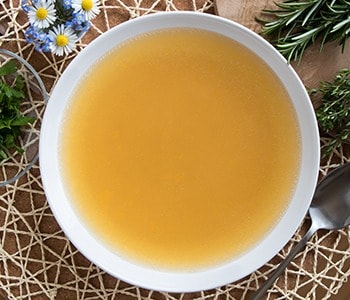 ROTH.
ROTH.
The benefits of bone broth to your immune system and gut health are many, but did you know that consuming quality bone broth on a regular basis can also help your skin maintain its elasticity and glow?
This is because bone broth contains collagen, which is extracted from the marrow part of the bone as it boils.
Collagen, along with keratin and elastin, is one of the major proteins that make up the skin; collagen alone represents about 70 percent of the overall protein in this organ. Collagen helps give strength to tissues and may even help improve skin barrier functions, according to a 2015 study published in the Journal of Cosmetic Dermatology.
#7 – MUSHROOMS.
Believe it or not, consuming mushrooms can not only boost your immune system, they can also significantly help with skin tone and skin hydration as well as prevent sagging.
There are actually quite a few mushroom types that contain substances that can give your skin a lift. Medicinal mushrooms contain polysaccharides which are able to help hydrate skin similar to hyaluronic acid, the body’s “natural moisturizer.”
Shiitake mushrooms, along with other kinds of mushrooms, contain kojic acid. Kojic acid is known to be a natural skin toner and lightener and some studies have connected kojic acid to inhibiting melatonin production on skin.
Many medicinal mushrooms – such as shiitake, reishi, and turkey tail mushrooms – also contain powerful antioxidants and anti-inflammatory compounds. These compounds can not only help protect the skin from environmental pollutants and oxidative stress, but may also provide support for inflammatory skin conditions such as eczema.
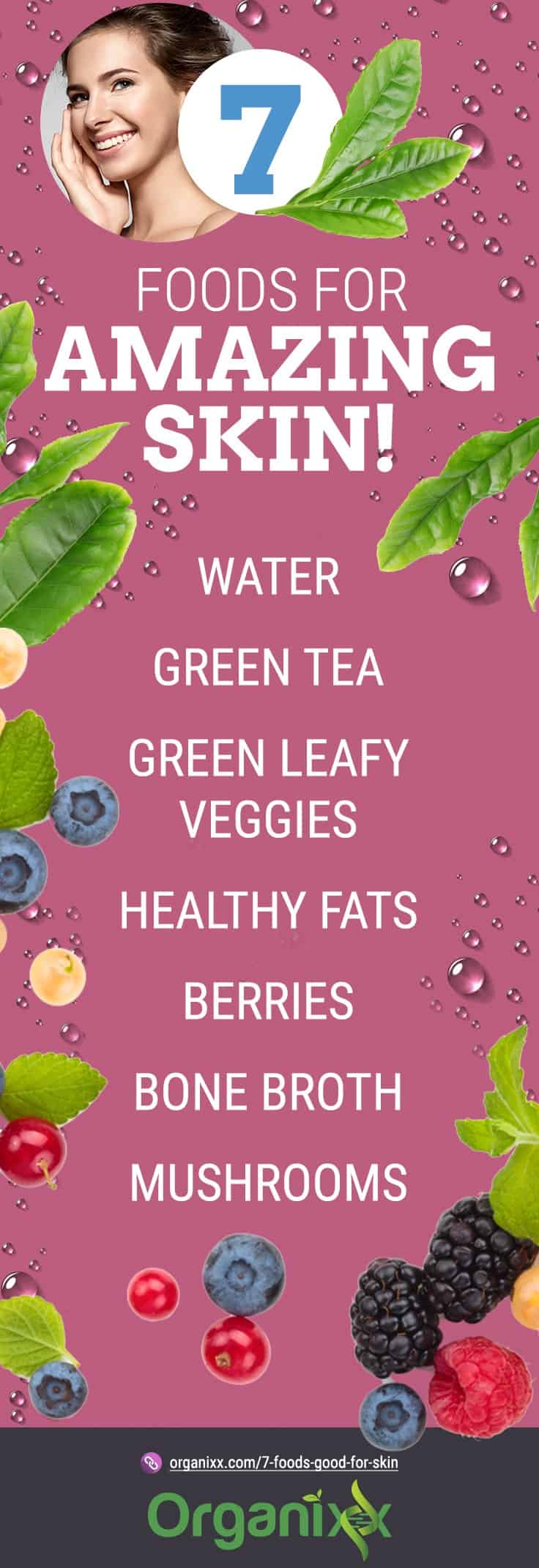
Your Skin is Affected by What Goes On It and What Goes In It
Remember that not only does your skin absorb everything you put on it, as the largest organ of your body, it is also intricately affected by every nutrient and harmful chemical you put in your body as well.
It makes sense that the seven foods good for skin mentioned above are also some of the best foods you can consume for your body as a whole. The logic is simple – what is good for the inside is good for the outside as well.
In addition, there are some things you should NOT put in your body that can help your skin health significantly. These include the “common culprits” that can lead to diseases of all kinds:
- Sugary foods
- GMO foods
- Trans fats
- Preservatives and additives
- Commercial meats that contain hormones and antibiotics
- Unfiltered tap water
Most of all, if you use sunscreen, lotion, or cream on your skin – whether it is for your face, your arms, your feet, or your entire body – make sure it is preservative-free and all-natural. Did you know that of the 10,000 chemicals used in personal care products, only 13% have been tested for safety?
Take care of your skin by being mindful of what you put ON your skin from the outside and how you affect your skin organ from the INSIDE as well. By doing this, you can not only have beautiful skin, you may also have amazing health at any age!
7 Mushrooms from Organixx contains 7 of nature’s most powerful mushrooms for anti-aging, longevity, and immune support. Using centuries-old knowledge of the power of nutritional mushrooms and our breakthrough new formulation process we’ve unleashed the power of mushrooms in a way never before done.




